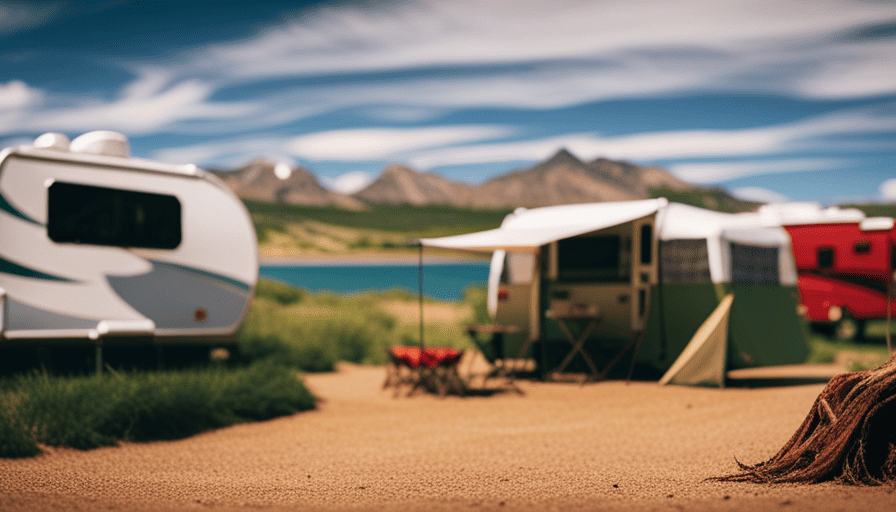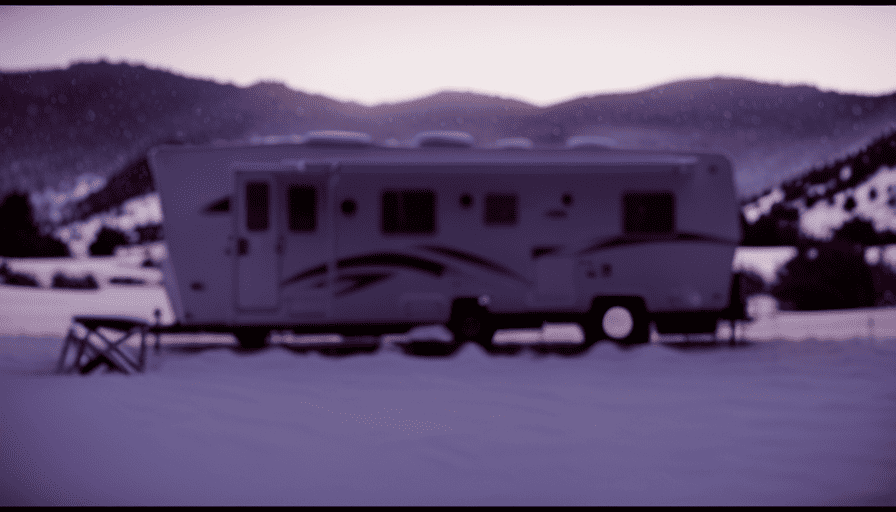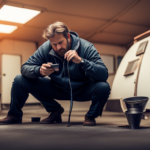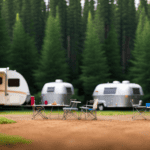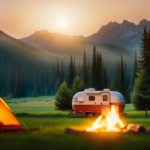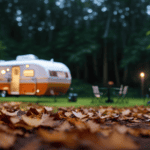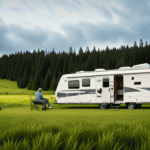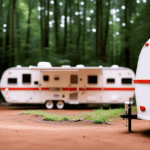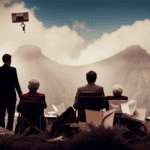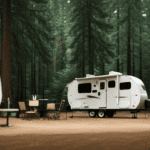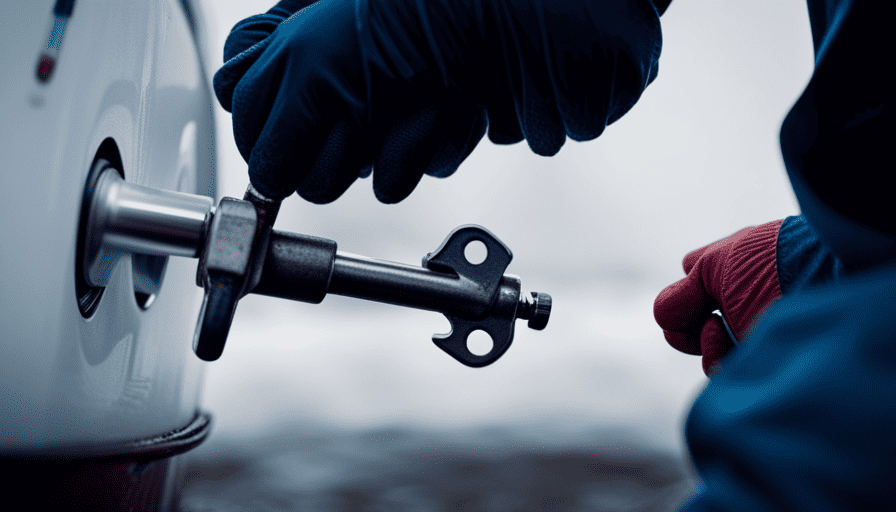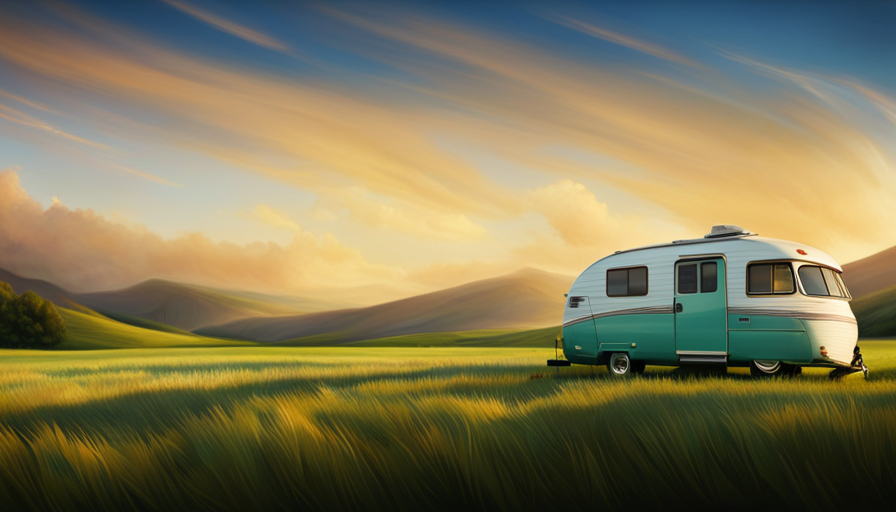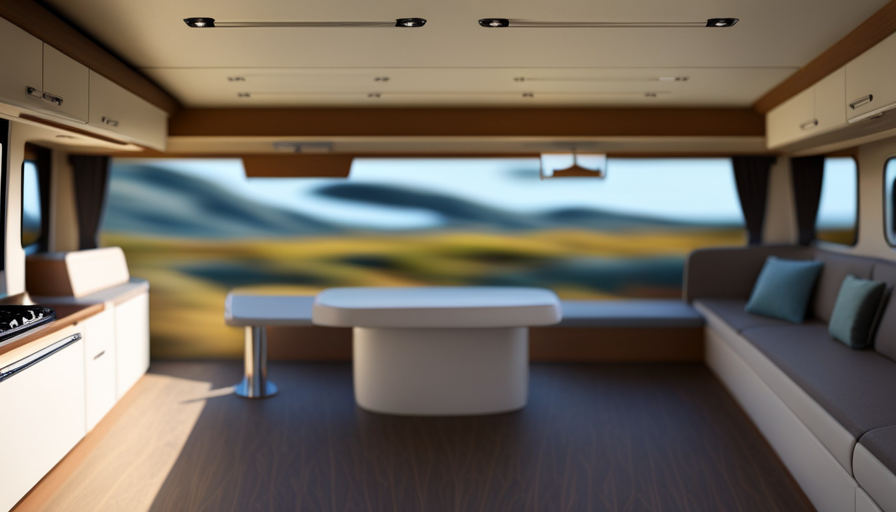Are you prepared to set off on the adventure of a lifetime? Imagine this: endless highways, the liberty to discover new places, and the cozy convenience of your own mobile home. Acquiring a camper is an exciting journey, yet it’s vital to tackle it with thoughtful deliberation.
In this guide, I will walk you through the process of buying a camper, step by step, ensuring that you make a well-informed decision that suits your needs and budget. First, we will explore the different types of campers available, such as pop-up trailers, travel trailers, and motorhomes, so you can choose the one that best fits your camping lifestyle. Next, we will discuss important factors to consider when evaluating the condition of a used camper, such as the age, maintenance history, and any potential red flags. Lastly, we will cover the cost of camper ownership, including upfront purchase expenses, ongoing maintenance and operating costs, and potential resale value. By the end of this guide, you will have all the information you need to confidently purchase the perfect camper for your outdoor adventures.
By juxtaposing the thrill of adventure with the practicality of making a wise purchase, we will explore the key factors to consider when buying a camper. From determining your needs and budget to researching different types of campers, you’ll discover everything you need to know to make the right choice.
Whether you’re a seasoned camper looking to upgrade or a first-time buyer eager to hit the road, this guide will equip you with the knowledge and confidence to find your perfect camper and begin your journey of a lifetime.
So, let’s dive in and start your camper-buying adventure!
Key Takeaways
- Determine your needs and budget before buying a camper
- Research different types of campers and popular brands
- Thoroughly inspect the camper for damages and issues
- Negotiate the price and arrange for insurance and registration
Determine Your Needs and Budget
Now it’s time for me to figure out what I truly need and how much I can afford in order to start my exciting camper-buying journey!
Determining the size of the camper is an important first step. I need to consider how many people will be using the camper and how much space we will need. If I plan on traveling with a large family or a group of friends, a bigger camper might be necessary. On the other hand, if it’s just me or a small group, a smaller camper might be more suitable.
Once I have determined the size, I can start choosing the right camper model. There are various types of campers available, such as pop-up campers, travel trailers, and motorhomes. Each has its own advantages and disadvantages, so I need to consider my preferences and needs. For example, if I want something compact and easy to tow, a pop-up camper might be a good choice. If I prefer more amenities and space, a motorhome might be the way to go.
Researching different types of campers will provide me with more information and help me make an informed decision. It’s important to compare features, prices, and reviews to find the camper that best fits my needs and budget.
So, let’s dive into the next section and explore the wonderful world of campers!
Research Different Types of Campers
Discover the diverse array of delightful and distinct types of campers available for purchase. When researching different types of campers, it is important to consider the pros and cons of each option. To help you make an informed decision, here is a comparison of three popular camper brands: Airstream, Winnebago, and Jayco.
| Camper Brand | Pros | Cons |
|---|---|---|
| Airstream | – Iconic design |
- Lightweight and aerodynamic
- Durable construction | – Expensive
- Limited floor plan options
- Can be difficult to find used models | | Winnebago | – Wide range of models and sizes
- Good resale value
- Many customization options | – Lower quality construction compared to Airstream
- Not as stylish
- Can be expensive for higher-end models | | Jayco | – Affordable price range
- Various floor plan options
- Good customer service | – Less durable construction
- Lower resale value
- Limited luxury features |
Each brand has its own strengths and weaknesses, so it’s important to prioritize what is most important to you. After considering the different types of campers and comparing the pros and cons of various brands, you can now move on to the next step of deciding whether to buy new or used.
Decide on New or Used
When deciding between purchasing a new or used camper, it’s crucial to carefully weigh the benefits and disadvantages to find the best fit for your individual needs. Here are the pros and cons of each option:
-
New Campers
-
Pros:
- Warranty coverage provides peace of mind.
- Modern features and technology.
- Customization options to suit your preferences.
-
Cons:
- Higher upfront cost.
- Depreciation can be significant.
- Limited selection compared to used campers.
-
Used Campers
-
Pros:
- Lower upfront cost, making it more budget-friendly.
- Greater variety and availability in the market.
- Minimal depreciation compared to new campers.
-
Cons:
- Potential maintenance and repair costs.
- Limited or no warranty coverage.
- Outdated features and technology.
Considering these factors, it’s important to evaluate your financial situation, camping preferences, and long-term plans. If you prioritize cutting costs and have some mechanical knowledge, a used camper might be the way to go. However, if you desire the latest features and want the peace of mind that comes with a warranty, a new camper is worth considering.
To ensure you make the right decision, next, we’ll discuss how to check for necessary features and amenities in both new and used campers.
Check for Necessary Features and Amenities
When considering buying a camper, it’s important to make a list of must-have features and amenities that are necessary for your comfort and convenience. This could include things like a comfortable bed, a functional kitchen, and a reliable heating and cooling system.
Additionally, it’s crucial to thoroughly inspect the camper for any damages or issues that may need to be addressed before making a purchase. By doing so, you can ensure that you’re making a well-informed decision and avoid any unexpected surprises down the road.
Make a list of must-have features and amenities
To ensure your camping experience is top-notch, don’t leave home without a camper that’s loaded with all the bells and whistles. When making a list of must-have features and amenities for your camper, consider your budget and specific needs.
Here are some key features and amenities to include:
-
Sleeping arrangements: Look for a camper with comfortable beds or sleeping areas that can accommodate your family or travel companions.
-
Kitchen facilities: Ensure the camper has a functional kitchen area with a stove, refrigerator, and storage space for food.
-
Bathroom facilities: Consider whether you need a camper with a bathroom and shower, or if shared campground facilities will suffice.
When buying a camper, it’s important to find one that meets your specific requirements. Once you have your list of must-have features and amenities, you can move on to inspecting the camper thoroughly for any damages or issues.
Inspect the camper thoroughly for any damages or issues
Take a moment to thoroughly inspect the camper for any damages or issues that may hinder your camping experience and leave you feeling frustrated and disappointed. It is essential to check for hidden damages that may not be immediately apparent. Start by examining the exterior for any signs of rust, dents, or scratches. Look closely at the roof, windows, and doors to ensure they are in good condition. Inside, inspect the walls, flooring, and furniture for any signs of water damage, mold, or wear and tear. To ensure a thorough inspection, consider consulting a professional mechanic who can identify potential mechanical issues. By taking the time to carefully inspect the camper for damages and issues, you can avoid any unpleasant surprises later on. Now, let’s move on to the next step and test drive and inspect the camper.
Test Drive and Inspect the Camper
Before finalizing my decision to buy a camper, I took it for a test drive to ensure it met my specific needs. The test drive allowed me to assess the performance and handling of the camper on the road, ensuring it was comfortable and easy to drive.
Additionally, I thoroughly inspected both the interior and exterior for any signs of wear and tear, such as leaks, cracks, or damage. This allowed me to make an informed decision and ensure I was investing in a camper that would provide me with a reliable and enjoyable camping experience.
Take the camper for a test drive to ensure it meets your needs
Immerse yourself in the camper experience by hitting the open road and discovering if it truly fulfills all your travel desires. Taking the camper for a test drive is an essential step in the buying process.
This experience allows you to assess the suitability of the camper for your needs. Start by checking the engine and ensuring it runs smoothly. Pay attention to how the camper handles on the road, especially when making turns or going uphill. Test the brakes and make sure they respond effectively. Take note of any unusual noises or vibrations. Additionally, consider the camper’s size and maneuverability. Will it fit comfortably in the places you plan to visit?
Once you have thoroughly tested the camper’s performance, it’s time to inspect the interior and exterior for any signs of wear and tear.
Inspect the interior and exterior for any signs of wear and tear
As you step inside, prepare to be amazed by the hidden treasures and not-so-hidden blemishes that adorn the interior and exterior of this potential travel companion. When inspecting the camper for signs of wear and tear, it is important to pay attention to both the interior and exterior components. Look for any cracks, dents, or scratches on the exterior body, as they may indicate previous accidents or rough usage. Inside, check for signs of water damage, such as soft spots on the floor or discolored walls. Pay close attention to the condition of the appliances, furniture, and fixtures, ensuring they are in good working order. Additionally, inspect the tires, brakes, and suspension for any signs of wear or damage. Taking note of these issues can help you determine the level of maintenance and repairs the camper may require in the future.
| Signs of Wear and Tear | Maintenance Tips |
|---|---|
| Cracks, dents, scratches on the exterior body | Regularly inspect and clean exterior surfaces |
| Water damage and soft spots on the floor | Check for leaks and repair any damage promptly |
| Malfunctioning appliances, furniture, and fixtures | Keep a maintenance schedule and address issues promptly |
| Worn tires, brakes, and suspension | Regularly check tire pressure and replace worn parts as needed |
| Faded or peeling paint | Regularly wash and wax the exterior to protect the paint |
Now that you have thoroughly inspected the camper, it’s time to consider financing options and make this dream a reality.
Consider Financing Options
Explore different financing options to make purchasing your dream camper a reality without breaking the bank. When considering financing for your camper, it’s important to compare interest rates and explore loan terms to find the best option that suits your budget and financial goals.
Here are four financing options to consider:
-
Traditional Bank Loan: Contact local banks and credit unions to inquire about their loan options specifically designed for recreational vehicles. Compare interest rates, loan terms, and repayment options to find the most favorable terms for your situation.
-
Dealer Financing: Many camper dealerships offer financing options directly to customers. These options may include competitive interest rates and flexible loan terms. Be sure to compare these options against other financing options to ensure you’re getting the best deal.
-
Online Lenders: There are online lenders that specialize in recreational vehicle financing. These lenders often offer quick and convenient application processes, competitive interest rates, and flexible loan terms. Research reputable online lenders and compare their offers to find the best fit for your needs.
-
Personal Loans: If you have a good credit score, you may be able to secure a personal loan from a bank or online lender. Personal loans can provide the flexibility to use the funds for your camper purchase while potentially offering competitive interest rates.
By exploring different financing options and comparing interest rates and loan terms, you can find the best option to finance your dream camper. Once you’ve secured financing, you’ll be ready to negotiate the price and make your camper dreams a reality.
Negotiate the Price
Haggling over the price of your dream mobile home can feel like a thrilling dance, where you and the seller engage in a lively negotiation to find the perfect balance between your budget and their asking price.
When it comes to negotiating the price of a camper, there are several strategies that can help you secure the best deal. First, do your research and gather information about the average price range for the type of camper you’re interested in. This will give you a starting point for your negotiation.
Next, set a price limit for yourself and stick to it. It’s important to know your budget and not be swayed by emotions or pressure from the seller. Be confident, but respectful, when presenting your offer and be prepared to provide reasons for why you believe the price should be lower.
Remember, negotiation is a two-way street, so be open to compromise. By utilizing these negotiation strategies and setting a price limit, you can increase your chances of getting a fair deal on your dream camper.
Transitioning into the next section about completing the purchase, it’s important to discuss the final steps after reaching an agreement on the price.
Complete the Purchase
Once you’ve successfully negotiated the price for your dream mobile home, it’s time to finalize the purchase and make it yours. There are a few important steps to take in order to complete the purchase smoothly.
Firstly, conducting a title search is crucial to ensure that the camper you’re buying has a clear title and is not encumbered by any liens or legal issues. This will protect you from any potential problems down the road. You can hire a professional to perform this search or do it yourself by contacting the relevant authorities.
Next, it’s important to thoroughly understand the legal documents involved in the purchase. This includes the bill of sale, which is a legal document that transfers ownership of the camper to you. Additionally, you may need to sign a loan agreement if you’re financing the purchase. Take the time to carefully read and understand these documents before signing anything.
Once you’ve completed the purchase, it’s time to arrange for insurance and registration. This will ensure that your new camper is protected and legally registered for use on the road. Research different insurance options and contact your local Department of Motor Vehicles to complete the registration process.
With these steps completed, you’re one step closer to hitting the open road in your new camper.
Arrange for Insurance and Registration
Now that you’ve completed the purchase of your dream camper, it’s important to take the necessary steps to ensure that you’re properly insured and registered. The insurance and registration process is a crucial part of owning a camper, as it not only protects your investment but also provides you with peace of mind during your adventures on the road.
Finding the right insurance provider for your camper is essential. Look for a company that specializes in RV insurance and offers comprehensive coverage. Consider factors such as the cost of insurance, the coverage options available, and the company’s reputation for customer service. It’s important to find a policy that meets your specific needs and provides adequate protection for your camper and belongings.
Once you’ve chosen an insurance provider, you’ll need to complete the registration process. This typically involves providing proof of insurance, filling out registration forms, and paying any necessary fees. The specific requirements may vary depending on your state, so be sure to research the regulations in your area.
With insurance and registration taken care of, you’re one step closer to hitting the road in your new camper. In the next section, we’ll discuss how to prepare for your first adventure and make sure you have everything you need for a successful trip.
Prepare for Your First Adventure
Before embarking on your first adventure with your new camper, it’s important to stock up on essential camping supplies and equipment. This includes items such as cooking utensils, bedding, and camping chairs.
Once you have everything you need, it’s time to plan your first camping trip and hit the road with your new camper! Choose a destination that suits your preferences and make sure to research any necessary permits or campground reservations.
With your camper fully equipped and your trip planned out, you’ll be ready to embark on an unforgettable camping experience.
Stock up on essential camping supplies and equipment
Don’t forget to gather all the must-have camping gear and equipment that’ll make your outdoor adventures unforgettable.
Here’s a camping gear checklist to ensure you have everything you need for a successful trip:
-
A high-quality tent: Look for one that’s easy to set up, durable, and provides enough space for your group.
-
Sleeping bags and sleeping pads: Opt for warm and comfortable options to ensure a good night’s sleep.
-
Cooking supplies: Bring a portable stove, cooking utensils, and a cooler to store food and drinks.
When planning your first camping trip and hitting the road with your new camper, it’s crucial to have all the necessary equipment. By following camping equipment reviews and investing in reliable gear, you can enjoy a worry-free adventure.
So, get ready to explore the great outdoors and create lasting memories with your new camper!
Plan your first camping trip and hit the road with your new camper!
Get ready to embark on your first camping adventure and hit the open road with your brand new camper! Planning your first camping trip is an exciting step towards enjoying the great outdoors and creating lasting memories. To ensure a successful journey, it’s essential to plan your camping essentials and choose the perfect camping destination.
When it comes to planning, make a checklist of the necessary camping supplies and equipment you’ll need, such as a tent, sleeping bags, cooking utensils, and first aid kit. Additionally, consider the type of camping you prefer, whether it’s primitive camping, RV camping, or glamping, and pack accordingly.
Choosing the perfect camping destination is crucial for a memorable experience. Research different campgrounds and consider factors like proximity to natural attractions, available amenities, and the desired level of solitude. Take advantage of the interactive table below to compare different camping destinations and make an informed decision.
| Campground Name | Proximity to Natural Attractions | Amenities | Level of Solitude |
|---|---|---|---|
| Camp A | Close | Basic | Moderate |
| Camp B | Far | Full | Secluded |
| Camp C | Moderate | Partial | High |
| Camp D | Close | Full | Moderate |
With a well-planned camping trip and the perfect destination, you’re ready to hit the road and enjoy the freedom and beauty of the great outdoors with your new camper!
Frequently Asked Questions
How do I properly maintain and care for my camper?
To properly maintain and care for my camper, I follow these camper maintenance tips and camper care guidelines.
First, I regularly inspect the exterior for any damage or leaks, and promptly repair them.
I also clean the camper inside and out to prevent dirt buildup.
Additionally, I check and maintain the tires, brakes, and electrical systems regularly.
Lastly, I store my camper in a dry and secure location when not in use, to protect it from the elements.
What are some common issues or problems that campers may experience?
Common camper repairs can include issues with the plumbing system, such as leaks or clogged pipes. Electrical problems are also common, like blown fuses or malfunctioning outlets. Troubleshooting camper electrical issues involves checking the power source, testing the fuses, and inspecting the wiring for any damage. It’s important to have a basic understanding of these repairs and troubleshooting techniques to ensure a smooth camping experience.
Regular maintenance and inspections can help prevent these issues from occurring in the first place.
Are there any specific safety precautions or tips I should know when using a camper?
When it comes to camper safety, there are a few important tips to keep in mind.
First, always check the tires and brakes before hitting the road.
Additionally, make sure to secure all belongings inside the camper to prevent them from shifting during travel.
It’s also crucial to have a fire extinguisher on board and to regularly check the smoke and carbon monoxide detectors.
Don’t forget to practice safe driving techniques and always be aware of your surroundings.
Lastly, trust me, mosquito repellent is an absolute must-have!
How can I find reliable and trustworthy camper repair and maintenance services?
When it comes to finding reliable and trustworthy camper repair and maintenance services, there are a few key steps I follow.
First, I ask for recommendations from fellow campers or RV clubs.
Then, I research online reviews and ratings to get a better sense of their reputation.
Next, I compare prices and services offered by different mechanics. It’s important to find a balance between quality and affordability.
Finally, I contact a few potential options to discuss my specific needs and get a better understanding of their expertise.
Are there any legal requirements or regulations for owning and using a camper in my area?
In my area, there are specific legal requirements and registration regulations for owning and using a camper. It’s essential to familiarize yourself with these rules to ensure compliance and avoid any potential legal issues.
Generally, you’ll need to register your camper with the appropriate government agency and obtain a license plate. Additionally, some areas may have specific regulations regarding insurance coverage, weight limits, and safety equipment.
It’s advisable to consult your local Department of Motor Vehicles or relevant authorities for precise information.
What Factors Affect the Approval Process for Buying a Camper?
When it comes to getting approved for a camper purchase, several factors influence the approval process. Lenders consider credit history, debt-to-income ratio, and employment stability. A good credit score and a low debt load can increase the chances of approval. Similarly, a steady income and employment record assure the lender of the borrower’s ability to make timely payments.
Conclusion
In conclusion, buying a camper can be an exciting and rewarding experience. By following the steps outlined above, you can confidently navigate the process and find the perfect camper for your needs.
Remember, knowledge is power, so taking the time to research and thoroughly inspect the camper is crucial. Don’t be afraid to negotiate the price and ensure you have the necessary insurance and registration in place.
Once all the details are sorted, you’ll be ready to hit the road and embark on your first adventure, making memories that will last a lifetime. So, don’t delay, start your camper buying journey today and let the open road be your oyster!

